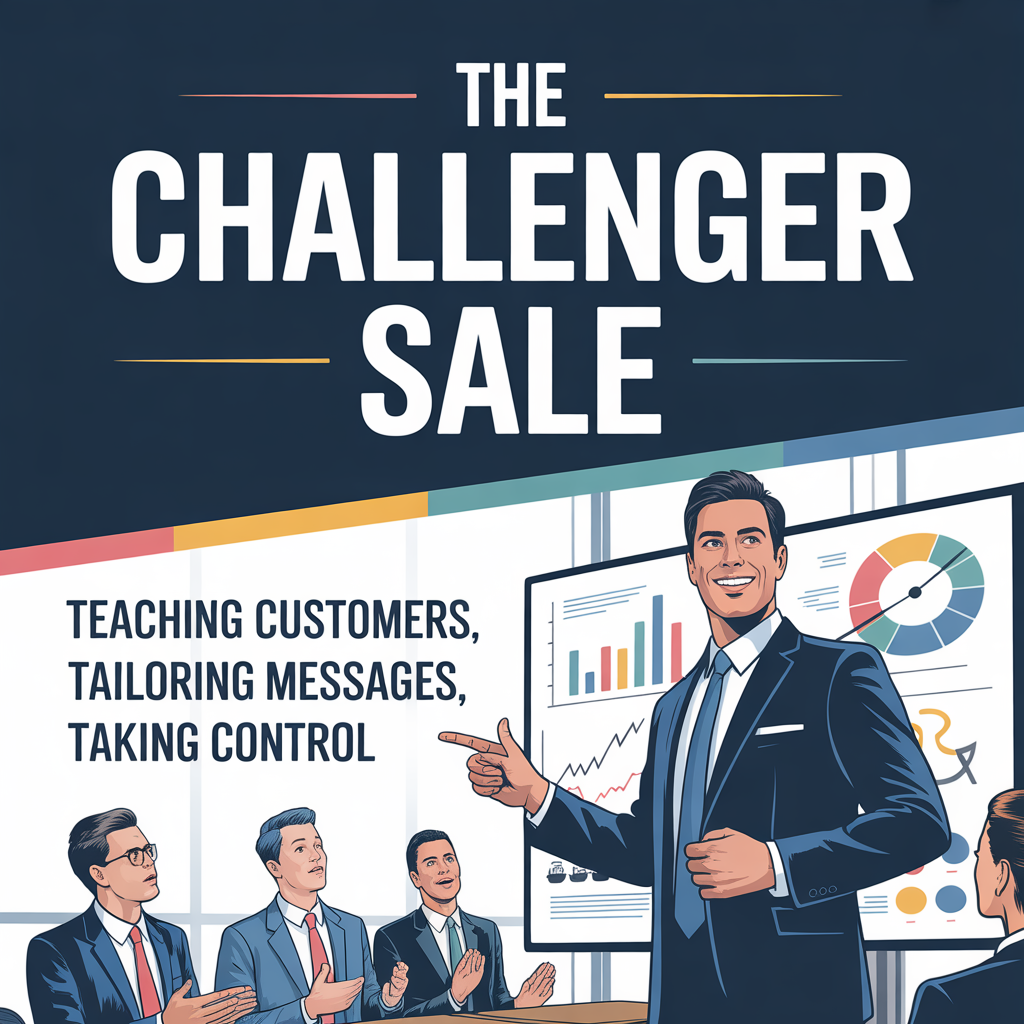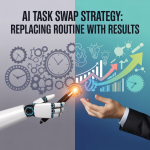
We’ll walk through:
The five core stages of a Challenger-style sales conversation
How to challenge customers’ assumptions at each stage
Practical examples and phrasing you can use
Quick Overview: The Challenger Approach
At its core, the Challenger model says top performers:
Teach for differentiation
Tailor for relevance
Take control of the sale (especially around money and next steps)
The distinctive “Challenger” move is that you don’t simply ask customers what they want and then respond.
You bring them an insight about their world that they did not ask for—often something that shows their current approach is riskier or more expensive than they realize.
A powerful Challenger-style sales conversation usually unfolds in five stages:
The Warm-Up
Reframe the Problem
Rational Drowning
Emotional Impact
A New Way & Your Solution
Let’s go through each one.
1. The Warm-Up
Goal: Build credibility and relevance without pitching yet.
This is where you show the customer you “get” their world—industry, role, pressures, trends. It’s not chit-chat; it’s context-building.
What you do in this stage
Share neutral observations about trends in their industry or segment
Reflect back what you see similar companies struggling with
Ask sharp, concise questions that reveal you understand their reality
“We’ve been working with a lot of regional retailers lately who are under intense pressure to grow e-commerce without killing store profitability. I’m curious—how are you seeing that tension play out in your world?”
How you begin challenging assumptions here
You lightly signal that there may be more beneath the surface than they think.
Instead of:
“What keeps you up at night?”
Try:
“Most leaders I speak with are focused on [X priority]. What I’m noticing, though, is that the real drag on performance is often [Y], which tends not to show up on dashboards right away. I’d love to explore whether that’s true for you as well.”
You’re not confronting yet—you’re opening a door to new thinking.
2. Reframe the Problem
Goal: Show them they’ve been defining the problem too narrowly—or even incorrectly.
This is where the Challenger approach really diverges from traditional solution-selling. Instead of accepting their initial problem statement, you reframe it with an insight.
What you do in this stage
Introduce an unexpected insight based on data, field experience, or benchmark comparisons
Show how a commonly accepted belief is incomplete or misleading
Use simple, visual language to reposition the issue
Example:
Customer’s framing:
“We need better training for our sales team because our close rate is dropping.”
Challenger-style reframe:
“Training might help, but what we’re seeing in the data is that close rates are dropping mostly because customers are increasingly 57–70% through their decision process before they ever talk to a rep. So the issue usually isn’t rep skill alone—it’s what the rep is walking in with. It’s whether they’re bringing a point of view that changes how the customer sees the problem.”
How to challenge assumptions here
Identify a specific assumption and pivot:
Assumption: “Our problem is price.”
“Price certainly comes up in every deal. What our clients often discover, though, is that when customers see a compelling cost-of-inaction story, price becomes less central. The issue is less ‘Are we too expensive?’ and more ‘Have we made the risk of doing nothing visible enough?’”
Assumption: “We have a lead-generation problem.”
“Lead volume matters, but when we look at the funnel, the bigger leakage is often in [stage]. That suggests a conversion problem more than a lead problem.”
You’re respectfully saying: “You’re aiming at the wrong target.”
3. Rational Drowning
Goal: Make the current situation feel logically untenable.
Here you support your reframe with data, numbers, and logic. You’re helping them “drown” in the rational consequences of staying as they are.
What you do in this stage
Quantify the cost of the status quo (lost revenue, wasted time, risk, etc.)
Use simple math to connect small inefficiencies to big outcomes
Introduce benchmarks: how they compare to peers or best-in-class
Example structure:
“Let’s put some numbers around this.
You’ve got 20 reps. If each rep loses just one winnable deal per month because they’re coming in too late or with no unique insight, at your average deal size of $8,000, that’s
20 reps × 1 deal × $8,000 × 12 months = $1.92M a year in missed revenue.
That’s the hidden cost of running the current playbook.”
How to challenge assumptions here
Most customers underestimate how bad the current situation is. You challenge that by:
Replacing vague language (“a bit of inefficiency”) with concrete data
Breaking costs into per week / per rep / per location to make it visceral
Showing how small problems compound over time
Phrases that help:
“On the surface it looks small, but when we zoom out over a year…”
“The part that surprised most leaders we work with is this…”
“When you line your numbers up against what we see in top-quartile performers, the gap looks like this…”
You are calmly making the status quo unacceptable from a business standpoint.
4. Emotional Impact
Goal: Move from “interesting insight” to “we have to act.”
Logic opens the door; emotion makes them walk through it.
In Challenger, this is about connecting the rational problem to human consequences—stress, missed goals, reputational risk, team burnout, etc.
What you do in this stage
Tell short, specific stories about similar customers who delayed change
Link the problem to what the buyer personally cares about:
Hitting their targets
Protecting their team
Their reputation as a leader
Career advancement or risk
Use contrast: before vs. after, stuck vs. confident, reactive vs. proactive
Example:
“One VP of Sales we worked with kept hearing, ‘We just need better objection handling.’ In reality, his team was getting commoditized because they weren’t bringing a unique point of view. He spent two years battling margin erosion and lost a key region director who burned out. Once he shifted to an insight-led approach, not only did win rates improve, but his team reported feeling more confident—they finally felt like trusted advisors rather than order-takers.”
How to challenge assumptions here
You’re challenging the assumption that “we can live with this”:
Assumption: “It’s painful, but it’s just how our industry is.”
“A lot of people thought that until they saw how much control they actually had over [specific metric]. The leaders who acted early are now the ones setting the standard everyone else is chasing.”
Assumption: “This is a small annoyance, not a major issue.”
“It looks like a small annoyance day-to-day, but over time it’s what creates staff turnover / missed targets / constant firefighting. That’s why this is often the silent killer of performance.”
You’re creating a sense of urgency that is earned, not manufactured.
5. A New Way & Your Solution
Goal: Introduce a different path that only your solution fully enables.
Only after reframing and building tension do you talk about your offering—but still through the lens of the new way of thinking you just introduced.
What you do in this stage
Present a new model or approach (“Here’s how high performers tackle this”)
Show how your solution is designed for that new model
Tie specific features to the insights and problems you surfaced earlier
Example flow:
Paint the new way at a high level
“The organizations that are breaking out of this pattern are doing three things differently:
equipping reps with disruptive insights early in the buy cycle,
tailoring conversation tracks by segment, and
enforcing a deal discipline that keeps them in control of the process.”
Connect your solution
“Our platform is built specifically around those three levers:
• The Insight Library gives reps conversation-ready, data-backed stories.
• The Playbook Engine tailors messaging by segment, deal size, and persona.
• The Deal Control workspace structures next steps and coaching around the Challenger behaviors we’ve discussed.”Anchor back to their metrics
“For you, that means not just training reps once, but hardwiring this new approach into how they sell every day—so that the $1.9M in at-risk revenue we talked about doesn’t keep quietly leaking out of the funnel.”
How to challenge assumptions here
Now you’re challenging the assumption that incremental changes to the current approach will fix things:
Assumption: “We can just tweak what we’re already doing.”
“Tuning the existing system might buy you a little improvement, but the core issue is that the current system was built around [old assumption]. To actually change the outcome, you need a system designed around [new assumption]. That’s what this approach—and our solution—is built for.”
You position your solution as the logical endpoint of the insight journey you’ve just led them through.
How to Challenge Customers’ Assumptions Without Being a Jerk
Challenger isn’t about being aggressive; it’s about leading. A few practical guidelines:
1. Ground your challenge in empathy and expertise
Start from: “I see something you might have missed, and I want to help.”
Use phrases like:
“What we’ve learned…”
“The pattern we see is…”
“May I offer a different way to look at this?”
2. Attack the problem, not the person
Avoid: “You’re wrong,” “You’re thinking about this incorrectly.”
Use: “Most organizations—including some very sophisticated ones—initially see it this way…”
You normalize their current view and then gently upgrade it.
3. Bring evidence, not opinions
Use customer stories, benchmarks, small math, and data trends.
Swap “I think” with “We’ve observed,” “Our data shows,” “In [X] case.”
4. Orchestrate constructive tension
You want a bit of discomfort—enough that they feel the need to act.
Don’t rush to reassure the moment they look uneasy.
Sit with the silence after you show the cost of inaction.
Then offer a path forward: “The good news is, this is solvable, and here’s how others have tackled it.”
5. Tailor the challenge to the persona
A CFO may respond best to risk and ROI.
A VP of Operations might care most about reliability and efficiency.
A frontline manager may care about team workload and burnout.
The same insight can be framed differently so it lands with each stakeholder.
Bringing It All Together
A strong Challenger-style sales conversation looks like this in practice:
Warm-Up – Demonstrate deep understanding of their world.
Reframe – Reveal that the real problem isn’t what they initially thought.
Rational Drowning – Quantify the cost of staying the same.
Emotional Impact – Connect that cost to what they personally care about.
A New Way & Your Solution – Show a different, better path that your offering uniquely enables.
By deliberately walking through these stages and thoughtfully challenging assumptions, you move from “vendor” to “strategic partner”—and you don’t just respond to demand, you create it.
















